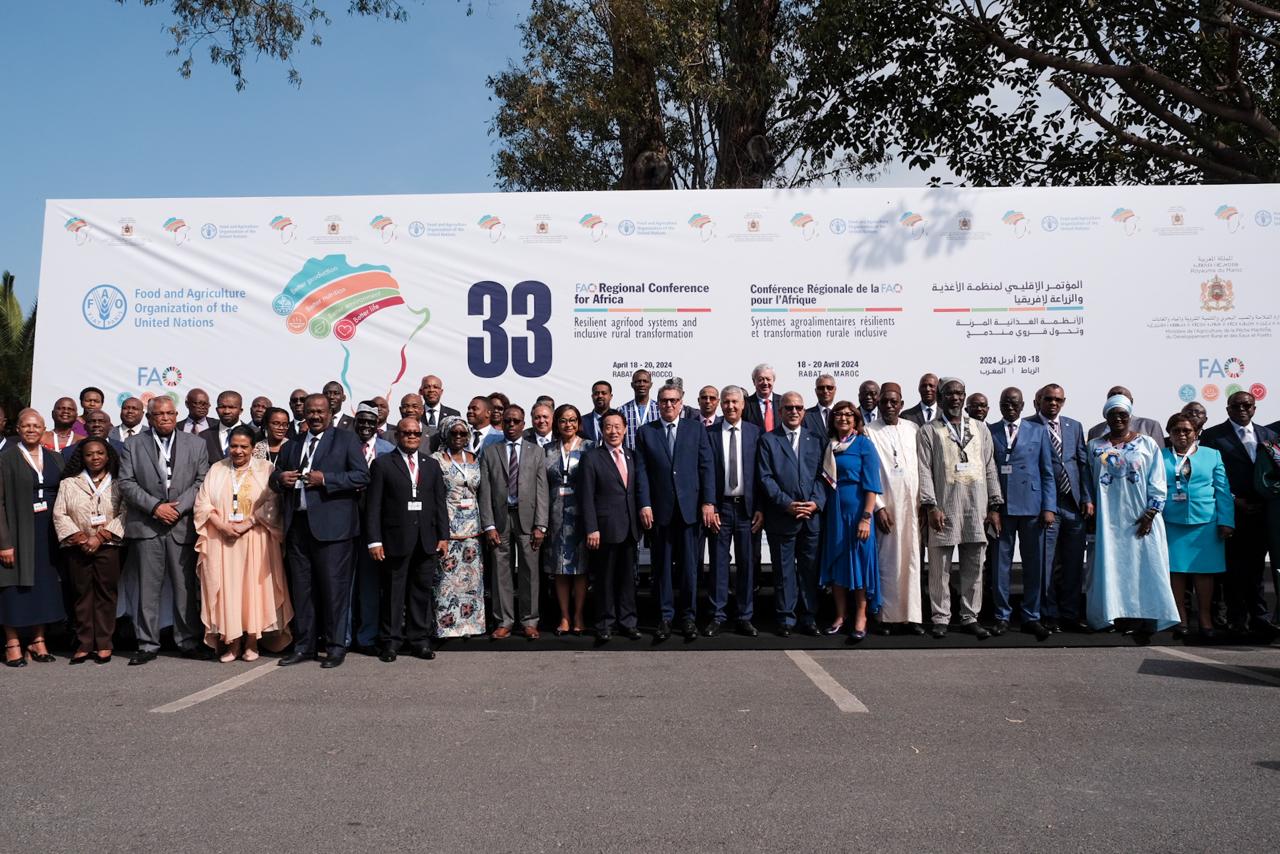Driving efficiency and productivity in Africa’s agriculture sectors requires strategic partnerships, greater investments, and the power of digital technologies
33rd Session of the FAO Regional Ministerial Conference for Africa opens in Morocco

Ministers gather with FAO Director-General QU Dongyu at the 33rd Session of the FAO Regional Ministerial Conference for Africa.
©FAO/Eduardo Soteras
“Africa boasts the largest area of arable land of any continent and is abundant in natural resources,” he said. “Africa’s young people offer extraordinary potential.”
Pushing forward on the regional agenda embodied in joint commitments such as the Maputo Declaration and Malabo Declaration will require charting a new course, together and now, to transform the continent’s agrifood systems, Qu said, calling for “strategic partnerships, greater investments, and harnessing the power of digital technologies to drive efficiency and productivity in Africa’s agriculture sectors.”
Hunger in Africa reached 19.7 percent in 2022, twice the global rate and up from 17 percent before the pandemic and up from an estimated 14.8 percent in 2012. Moreover, 868 million Africans, 61 percent of the population, did not have access to adequate food in 2022, and around 146 million people in 36 countries may have faced acute food security. (IPC3 or higher). At the same time, hunger rates vary enormously within Africa, with low rates in countries such as Algeria and Ghana and rates close to or even above 50 percent in others such as Madagascar and Central African Republic.
“You have to have and help farming,” said Prime Minister Aziz Akhannouch of Morocco in his opening remarks, during which he outlined the Kingdom’s substantial multiyear investments in enhancing irrigation and water efficiency as well as other agrifood initiatives that have improved rural incomes. “Putting investment at the center of the farming equation” is also central to Morocco’s Green Generation plan promoted by King Mohammed VI, the prime minister said.
The ARC33 enables high-level consultations to identify key priorities in the Region to be taken into account in preparing FAO’s Programme of Work and Budget for the next biennium.
The Four Betters – Better production, better nutrition, a better environment and a better life – are the cardinal points of FAO’s Strategic Framework 2022-31 and roadmap towards more efficient, more inclusive, more resilient and more sustainable agrifood systems. They “are not just a vision – they are a call to action,” the Director-General said.
Leveraging opportunities
While protracted conflicts are a major obstacle to progress and impose a hefty burden on rural populations, as do the impacts of the climate crisis, Africa is home to many of the fastest-growing economies in the world, and the emerging shift to a continental free trade area promises to reinforce its potential, making it a natural destination for investments.
36 sub-Saharan African countries have now joined FAO’s Hand-in-Hand Initiative, and investment plans for the region now exceed $12 billion. Ten countries in the region are currently participating in the FAO 1000 Digital Villages Initiative, 29 in FAO’s One Country One Priority Product initiative, and 16 have rolled out the Agricultural Information Management System (AIMS). FAO has also mobilized more than $91 million from the Global Environmental Facility and the Green Climate Fund for projects in Africa. These figures highlight FAO’s success in forging effective and strategic collaboration with resource and technical partners in the country and enable greater dynamism and agility going forward.
The Director-General flagged an array of FAO innovative initiatives in the region, including one using drones to deliver quality germ cells for livestock reproduction in Rwanda, another using the larvae of black flies to turn food waste into organic fertilizer in the Côte d’Ivoire, and another using DNA sequencing to assure the integrity of avocado seedlings in the United Republic of Tanzania. More local highlights are detailed here.
Qu urged ministers to use the ARC33 to exchange knowledge and best practices so as to enable each country to take its own lead in transforming its agrifood system. FAO stands ready to continue to support these journeys, he added.
The Regional Conference features several special events including ministerial roundtables that will investigate emerging technologies, climate resilience strategies, market dynamics, the potential of aquatic foods, agricultural mechanization, digitalization, inclusive policies empowering women and youth, biodiversity challenges, desertification and livestock development strategies.
Contact
FAO News and Media (+39) 06 570 53625 [email protected]
Christopher Emsden FAO News and Media (Rome) (+39) 06 570 53291 [email protected]
